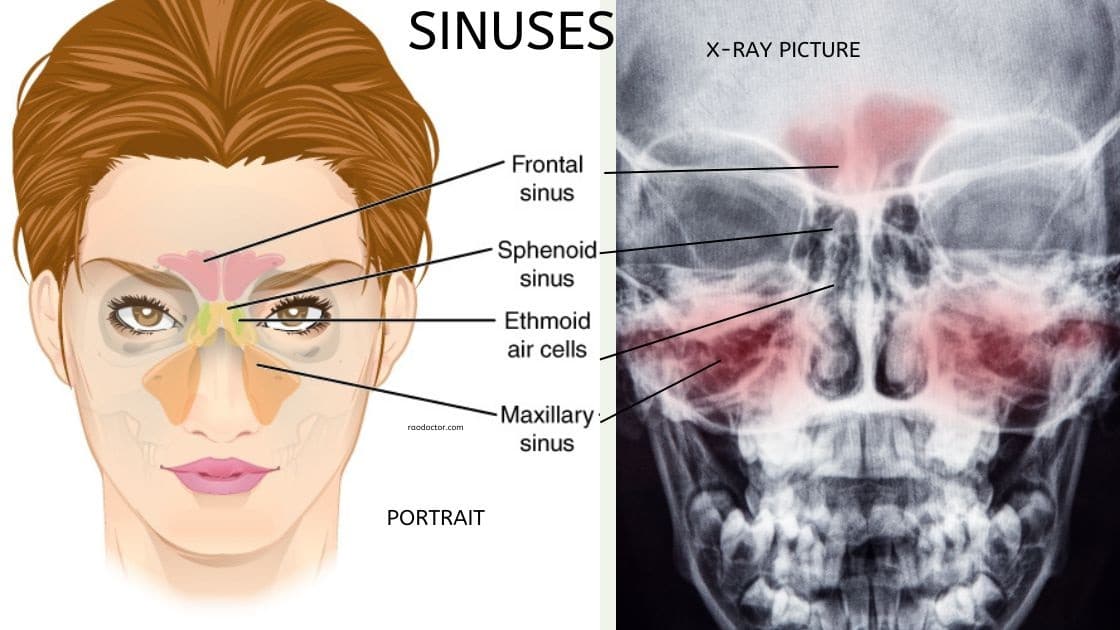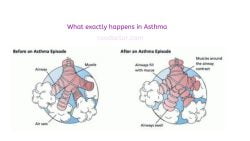Table of Contents
Introduction to Common Diseases of the Nose and Throat
Our upper respiratory tract is made up of the nose, throat or pharynx and the ear and in today’s article, we will learn about common diseases of the nose and throat.
If we look at the cross section of our upper part of our body [head up to neck] as shown below, you can make out the various structures that make upper our upper respiratory tract.

There are over 60 different diseases of the nose, throat and ear that can affect people of all ages. Symptoms range from a mild tickling sensation in the nose to something more serious like severe pain and fever due to sinusitis and tonsillitis.
Although most of these conditions are not life-threatening, it is important to see your doctor as soon as possible if you think you might have an infection or other problem with one of these areas.
In India, and in almost all the countries in the world, the monsoon season is the most common time when these common diseases of the nose and throat make their appearance.
Being able to recognize any warning signs and know when to get help is the best way to prevent more serious issues developing.
So, without much ado, let us discover these illnesses and aliments and what you can do about them. You should be able to find what you’re looking for in the lines below-
Common Diseases of Tonsils
What are tonsils?
Tonsils are part of your immune system that help protect your body from harmful germs that enter through your mouth or nose.

They are located in the back of your throat and contain white blood cells that fight infection. They also alert other immune cells to respond to pathogens¹.
The purpose of tonsils is to trap and kill germs that may cause diseases such as tonsillitis, which is an inflammation or infection of the tonsils. Tonsillitis can be caused by bacteria or viruses and can be acute (short-term) or chronic (long-term). Sometimes, tonsils may need to be removed by surgery if they cause problems such as obstructive sleep apnea, frequent infections, or difficulty breathing or swallowing².
There are three pairs of tonsils in your throat: –
- pharyngeal tonsils (also called adenoids), which are behind your nose.
- palatine tonsils, which are on both sides of the back of your throat; and
- lingual tonsils, which are at the back of your tongue. You can see your palatine tonsils when you open your mouth wide and look in the mirror. They are pinkish, oval-shaped masses of tissue that can vary in size from person to person.
Useful Resource-Tonsils.
One of the most common upper respiratory infections that brings patients to my clinic is sore throat. Now, a sore throat can be due to two conditions- Tonsillitis and Pharyngotonsillitis. Let us now learn all about tonsillitis-
Tonsillitis is the inflammation of the tonsils, two oval-shaped pads of tissue at the back of the throat — one tonsil on each side. Most cases of tonsillitis are caused by infection with a common virus, but bacterial infections also may cause tonsillitis.
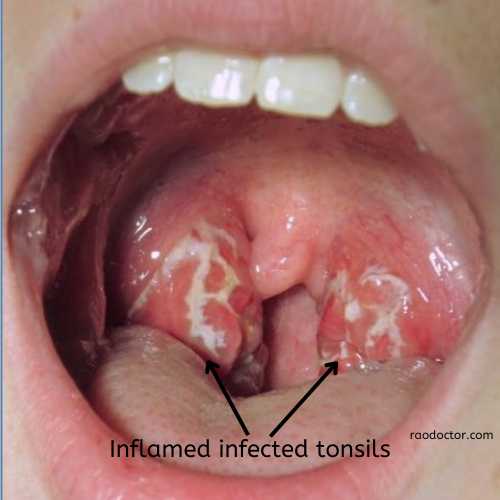
Common signs and symptoms of tonsillitis include
- red, swollen tonsils, sometimes with white or yellowish patches of infections on it [as shown above]
- sore throat,
- difficulty swallowing,
- fever,
- enlarged tender glands in the neck,
- bad breath,
- stomachache,
- neck pain or stiff neck.
In young children who are unable to describe how they feel, signs of tonsillitis may include drooling due to difficult or painful swallowing, refusal to eat and unusual fussiness.
Complications from frequent or ongoing (chronic) tonsillitis can include-
- disrupted breathing during sleep (obstructive sleep apnea),
- infection that spreads deep into surrounding tissue (tonsillar cellulitis),
- infection that results in a collection of pus behind a tonsil (peritonsillar abscess) ¹.
Prevention includes avoiding close contact with people who are sick, washing your hands frequently and thoroughly, not sharing food or drink with others and covering your mouth when you cough or sneeze¹.
Treatment and prevention of tonsillitis
Before I discuss the various medicines used in treatment of tonsillitis or any other condition mentioned in this article, I would like to state that the medicines mentioned in this article should not be considered as a prescription- let your attending doctor decide the line of treatment for you.
Treatment for tonsillitis depends on the cause. Antibiotics are commonly prescribed to treat bacterial tonsillitis, such as penicillin or amoxicillin. These medications help eliminate the bacteria causing the infection.
Examples of antibiotics used for tonsillitis treatment include:
- Penicillin: This is the most commonly prescribed antibiotic for tonsillitis.
- Amoxicillin: This is a broad-spectrum antibiotic that is effective against many types of bacteria.
- Cephalexin: This is another antibiotic that may be prescribed if a patient is allergic to penicillin.
Anti-inflammatory drugs can also be used to help reduce pain and inflammation associated with tonsillitis. This includes medications such as:
- Ibuprofen: This non-steroidal anti-inflammatory drug (NSAID) can help relieve pain and reduce inflammation. I usually use either chymosin-trypsin combination[Chymoral] or serratiopeptidase [Cipzen, Emanzen] to speed up the recovery in adults.
- Acetaminophen: This is another over-the-counter medication that can help alleviate pain and reduce fever.
- Medicated gargles like Betadine, Hexidine.
- Over-the-counter throat lozenges or sprays containing ingredients like benzocaine or menthol can help soothe a sore throat caused by tonsillitis.[e.g. Kofol, Cofsils, Alex]
It’s important to note that viral tonsillitis cannot be treated with antibiotics, as they are only effective against bacterial infections. In such cases, only anti-inflammatory drugs and gargling with warm salt water or Betadine gargles is sufficient.
Self-care for Tonsillitis
In addition to medication, there are several self-care methods that can help relieve symptoms and promote healing:
- Gargling with warm saltwater: This can help soothe a sore throat and reduce inflammation.
- Drinking plenty of fluids: Staying hydrated can help thin mucus and relieve throat discomfort.
- Resting and getting enough sleep: Resting allows the body to heal and recover more efficiently.
- Using a humidifier: Adding moisture to the air can help relieve throat irritation and congestion.
- Avoiding irritants: It’s best to avoid smoking, exposure to secondhand smoke, and other irritants that can further aggravate the throat.
- Consuming soft, cool foods: Eating soft foods like soups, yogurt, and smoothies can help soothe the throat.
It’s important to follow the prescribed treatment plan and complete the entire course of antibiotics, even if symptoms improve before the medication is finished.
If symptoms worsen or persist despite treatment, it’s essential to consult a healthcare professional for further evaluation and possible
Surgery to remove tonsils is usually performed only when tonsillitis occurs frequently, doesn’t respond to other treatments or causes serious complications¹.
Useful Resources-
Acute nasopharyngeal infection
Previously, I wrote an article on common infective diseases. In that I have discussed Common Cold, one of the upper respiratory tract infections.
An acute nasopharyngeal infection is a viral infection that causes a high fever and inflammation in the area of the nose and throat.
There are two common infections that affect the throat. They are Pharyngitis and Tonsillitis. The images shown below show how they appear when your physician or doctor examines your mouth.
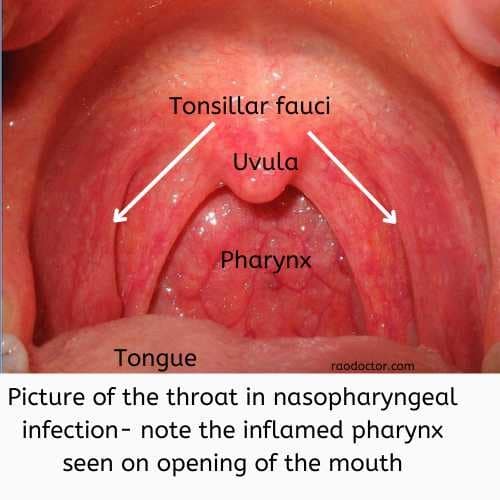
It is most common in children and can be very serious in those less than 6 months old.
Symptoms include a high fever, cough (which may produce green or yellow mucus), and an inability to breathe out of the nose. It is usually treated with antiviral medications and rest.
If left untreated, the infant can develop complications in their lungs, as well as suffer from dehydration through not being able to drink from a bottle.
A nasopharyngeal swab can identify the virus and help treat it. This infection is very contagious and can be passed through coughing, sneezing and touching contaminated objects.
Treatment, self-care and preventive methods are the same as for tonsillitis. Additionally, I prescribe a cough syrup containing dextromethorphan to relieve irritating cough. Example- Planokuf-D, Alex, Tossex syrups etc.
Common diseases of the Sinus
A sinus infection, or sinusitis, occurs when mucus in the sinuses becomes infected. This is often caused by a viral or bacterial infection but can also be caused by allergies.
It usually starts with the typical viral symptoms of a stuffy nose and headache, but then progresses to include pain in the cheekbones, teeth and forehead.
The infection is diagnosed with a CT scan or MRI, or by examining the fluid drained from the sinuses. It is treated with antibiotics and nasal irrigation, or a neti pot. A surgery may be required in severe cases.
Acute Sinusitis
Before we learn about this condition, let’s learn a bit about what sinuses are. Sinuses are air-filled chambers that give shape and look to our face.
They are lined with mucus membranes that produce fluid called mucus. This mucus flows into our nose and throat through small openings called ostium, keeping our nasal and throat lining moist.
Have a look at the pictures below to see how they appear-
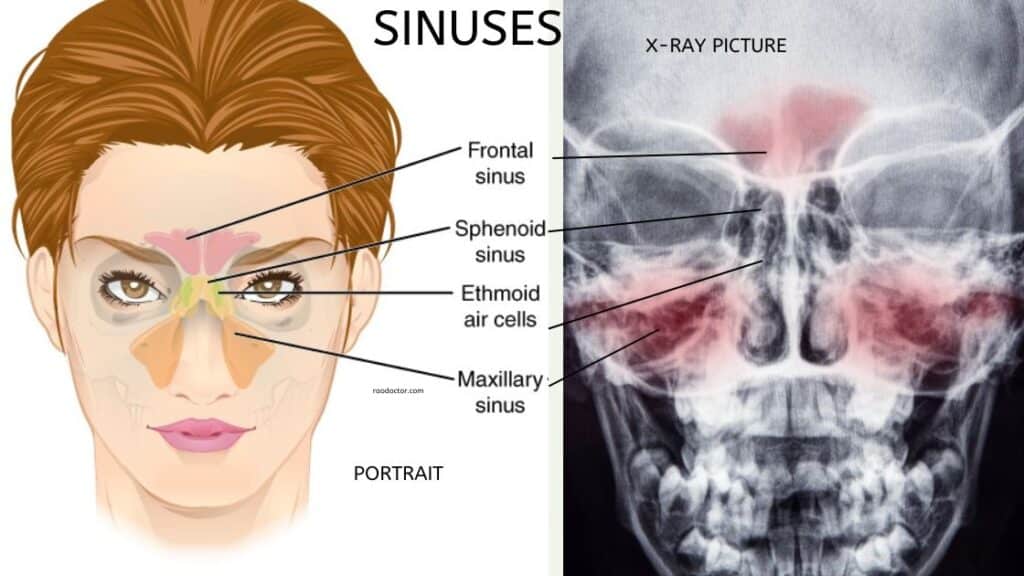
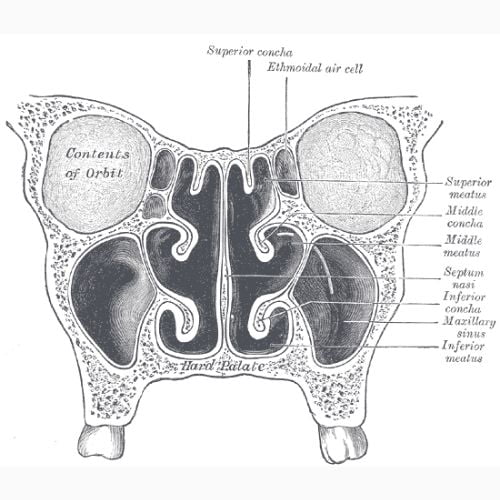
Acute sinusitis is a bacterial or viral infection in one or more of the cavities in the sinuses. It is very common, particularly in the winter season, and can be caused by a cold or other viral infection. People with chronic sinusitis may develop acute sinusitis.
Some of the common signs and symptoms of sinusitis are:
– Thick, discolored discharge from the nose (runny nose)
– Drainage down the back of the throat (postnasal drainage)
– Blocked or stuffy (congested) nose causing difficulty breathing through your nose
– Pain, tenderness and swelling around your eyes, cheeks, nose or forehead
– Reduced sense of smell and taste
USEFUL RESOURCE-ACUTE SINUSITIS
Symptoms include a cough or runny nose, facial pain, headache, and congestion. The infection usually spreads from the nasal passages to the sinuses causing acute sinusitis, and then to the ears or the lungs, if not treated promptly.
A person with acute sinusitis may have some of the following symptoms: –
- Fullness or pain in the face, especially around the temples and cheeks –
- Pus in the nasal discharge, often yellow or green
- Headache
- Bad breath
- Fever
- Swollen eyelids
- Earache [sometimes]
- Coughing
- Bad taste in the mouth
Chronic rhinosinusitis
Chronic rhinosinusitis is a long-term bacterial or viral infection of the sinuses. It often starts as acute sinusitis, but the inflammation lasts longer than 10-14 days.
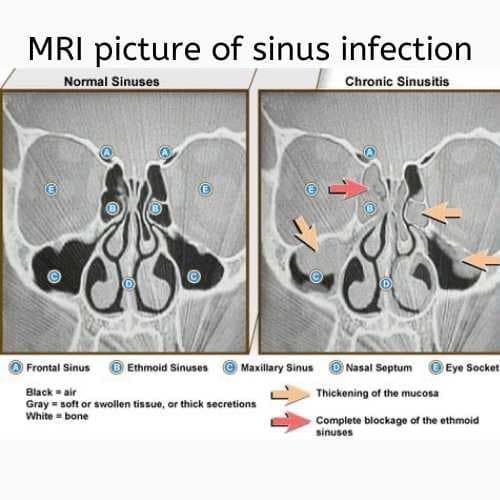
Chronic rhinosinusitis can have a significant impact on quality of life and can require long-term treatment. Symptoms include a cough or runny nose, facial pain, headache and congestion.
People with chronic rhinosinusitis may have some of the following symptoms: –
- Fullness or pain in the face, especially around the temples and cheeks
- – Pus in the nasal discharge, often yellow or green
- – Headache
- – Bad breath
- – Bad taste in the mouth
- – Fever
- – Swollen eyelids
- – Earache
- – Coughing
- – Pulling or tugging at the ears
Useful resource: Chronic Sinusitis
Nasal Congestion and Runny Nose (rhinorrhea)
Nasal Congestion and Runny Nose (rhinorrhea) are very common and are often caused by common colds. Fluid can build up in the nose and be released through the nostrils. It is this that causes the “runny nose”. This can be a sign of many different conditions, from allergies to infections.
Causes mostly include: –
- Allergies
- Sinus infections
- Tumors
- Polyps
- Trauma like head injury where we can sometimes get rhinorrhea due to leakage of cerebrospinal fluid [CSF].
- Trapping mucus in nasal cavities and opening up on turning your head. It can also be treated with saline nasal sprays or decongestants like oxymetazoline [ Nasivion, Otrivin]
Conclusion
The ear, nose, and throat are all interconnected, so it is important to take care of all three areas. With so many different diseases covered here, you should be able to find what you’re looking for, whether you need information on how to treat a common cold or are worried about a more serious condition like sinusitis or tonsillitis.
My next article will be on Common Diseases of the Ear. If you have found this article useful, do consider sharing it with your friends and family relations by using the social media icons at the bottom of this article.
You can also share it on Twitter by Click to Tweet below-
Common Diseases of the Nose and Throat Share on XAdios.

